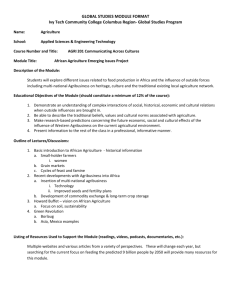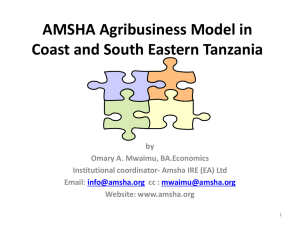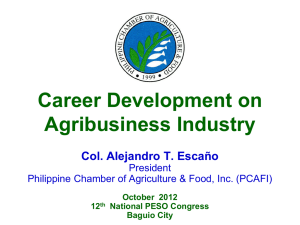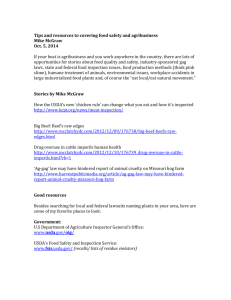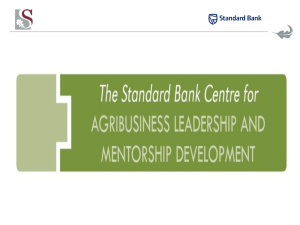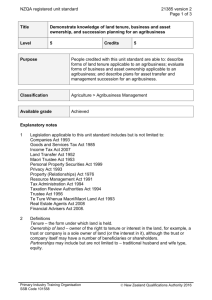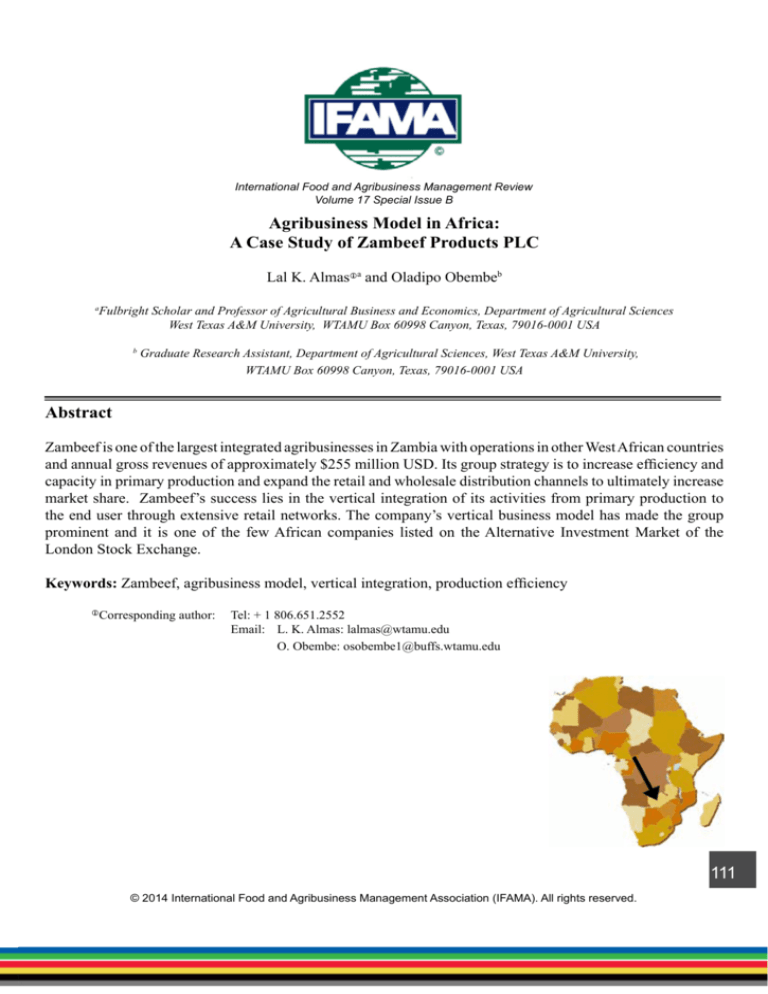
International Food and Agribusiness Management Review
Volume 17 Special Issue B
Agribusiness Model in Africa:
A Case Study of Zambeef Products PLC
Lal K. Almasa and Oladipo Obembeb
Fulbright Scholar and Professor of Agricultural Business and Economics, Department of Agricultural Sciences
West Texas A&M University, WTAMU Box 60998 Canyon, Texas, 79016-0001 USA
a
b
Graduate Research Assistant, Department of Agricultural Sciences, West Texas A&M University,
WTAMU Box 60998 Canyon, Texas, 79016-0001 USA
Abstract
Zambeef is one of the largest integrated agribusinesses in Zambia with operations in other West African countries
and annual gross revenues of approximately $255 million USD. Its group strategy is to increase efficiency and
capacity in primary production and expand the retail and wholesale distribution channels to ultimately increase
market share. Zambeef’s success lies in the vertical integration of its activities from primary production to
the end user through extensive retail networks. The company’s vertical business model has made the group
prominent and it is one of the few African companies listed on the Alternative Investment Market of the
London Stock Exchange.
Keywords: Zambeef, agribusiness model, vertical integration, production efficiency
Corresponding author: Tel: + 1 806.651.2552
Email: L. K. Almas: lalmas@wtamu.edu
O. Obembe: osobembe1@buffs.wtamu.edu
111
© 2014 International Food and Agribusiness Management Association (IFAMA). All rights reserved.
Almas and Obembe / International Food and Agribusiness Management Association Review / Volume 17 Special Issue B, 2014
Introduction
Zambeef was a small beef company before its incorporation in 1994. With limited capital and a staff of 60, they
began by slaughtering 180 cattle per month in a rented abattoir, delivering meat in a Land Rover and selling
the meat through two rented butcheries. Since its inception, Zambeef has expanded exponentially to become
one of Zambia’s largest agribusinesses with annual revenues of more than $255 million USD and currently
employs over 5,500 people. Zambeef has become one of the biggest players in the Zambian agricultural
industry by overcoming major problems hindering its rivals and forging ahead in delivering low cost protein
in the West Africa region. The company is expanding through an acquisition of other companies involved in
agricultural production. Zambeef reached a concessional agreement with Shoprite back in 1995 to manage 20
butcheries owned by them throughout Zambia. Between 2005 and 2007, Zambeef expanded to Nigeria and
Ghana in partnership with Shoprite, and in 2008 acquired Master Pork Limited, Zamanita Limited, Chiawa
Farm Asset, and Zampalm. Zambeef was listed on the
Lusaka Stock Exchange in 2003 and only carried out its
first equity capital raise in 2008. In June 2011, Zambeef
successfully concluded its dual listing on the Alternative
Investment Market (AIM) of the London Stock Exchange
and the rights issue in Zambia. The majority of the proceeds
from its listing on the AIM of the London Stock Exchange
are used to expand the company’s cropping operations
through the purchase of Mpongwe Farm. The Zambeef
group is principally involved in the production, processing,
distribution and retailing of beef, chicken, pork, milk, dairy
products, eggs, edible oils, stock feed, flour and bread
(Zambeef Products PLC. 2012).
The Company’s revenue increased from $162 million in 2010 to $207 million in 2011 and eventually rose to
$255 million in 2012(Zambeef Products PLC. 2012). The process of integration links following four divisions
of the company:
• The farm division mainly consists of Huntley Farm, Sinazongwe Farm, Chiawa Farm, Mpongwe Farm and
the palm plantation. Zambeef has one of the largest irrigated cropping operations in Zambia;
• The meat and dairy division consists of feedlots and abattoirs, chicken layers, chicken broilers and abattoirs,
dairy farms and piggery and pig abattoirs. Zambeef started as a small beef company, but has grown to be
the largest supplier of beef in Zambia. The company has the following operational facilities in Nigeria: two
processing plants, four self-operated butcheries, five Shoprite butcheries and a farm site to house proposed
feedlot, abattoir, cold room and processing operations;
• The third division is the manufacturing /processing division which involves the production of edible oils,
stock feed, leather and shoes. Zambeef has different plants involved in manufacturing, processing and
adding value to agricultural produce. The company has a wheat mill and a bakery for bread production,
tannery, and shoe plants to add value to the byproduct from the beef abattoir like cattle hides that are used
in producing leather and footwear;
112
© 2014 International Food and Agribusiness Management Association (IFAMA). All rights reserved.
International Food and Agribusiness Management Association Review / Volume 17 Special Issue B, 2014
• Zambeef has its own retail division which is involved in the distribution of its products in Zambia, Africa,
Europe, and Asia. Zambeef is in partnership with Shoprite to distribute their products in countries where
ShopRite is located.
The stability in Zambia’s economy and politics cannot be excluded from the company’s history. The increase
in Zambian prosperity has been the engine for the growth of Zambeef. As one of the largest employers in the
country, Zambeef provides jobs to thousands of Zambians and has helped to reduce unemployment in the
country. Staff training provides enormous opportunities to local businesses through business dealings and
knowledge transfer which increases their manpower to perform more efficiently. Zampalm1, a subsidiary of the
company worked with the community of operation to address the issue of health, education and agriculture.
The subsidiary also collaborated with local government development to establish a health clinic for the benefit
of the villages and the workers. The company also subscribes to United Nations Millennium Development
Goals, which aims at reducing child mortality and malaria in Zambia.
Current Management Structure
The company is led by a Board of Directors consisting of ten executive and non-executive directors. Francis
Grogan and Carl Irwin2, two of the joint directors on the Board, have led the development of the business since
1994. The management team consists of directors with backgrounds in managing public companies. Specific
fundamental, strategic and formal matters are reserved for the board’s decision. The Board has sub-committees
headed by different directors to assist the board in developing strategies that will make the company sustain
profitability in the market. The committees operate within a defined terms of reference as instructed by the
Board.
The main emphasis in such terms is to promote the company’s success in the light of strategic, operational,
business and industry issues as they rise from time-to-time and make recommendations to the Board and
ensure strategic goals and objectives shaped at the Board meetings are translated into tactical delivery with
mechanisms for key performance criteria in place to monitor progress. Directors of Zambeef recognize the
value of corporate governance and endorse principles of openness, integrity, transparency, accountability and
the application of high ethical standards in the conduct of business. The directors are of different nationalities
with years of experience in multidisciplinary professions.
Key Success Factors
Zambeef’s vision and strategy is to be the most accessible and affordable quality protein provider in the region
and to increase the efficiency and capacity of its primary production facilities. Zambeef has been able to
overcome some of the challenges facing agriculture as a business in Africa by continuously pursuing a vertically
Zampalm signed a social responsibility contribution agreement with Kopa Community Development in October 2009 to contribute
$1USD per hectare per year.
2
Francis Grogan is the Chief Executive Officer with over 22 year experience in agriculture and meat including experience with the
United Meat Packers Ireland, one of Europe’s largest meat companies. Carl Irwin is the director of strategy and development with
over 20 years of experience in accounting and finance.
1
113
© 2014 International Food and Agribusiness Management Association (IFAMA). All rights reserved.
Almas and Obembe / International Food and Agribusiness Management Association Review / Volume 17 Special Issue B, 2014
integrated business model (farm to fork). The company integrated its operations through acquisition and
expansion of existing operations, which has also increased its efficiency in the delivery of products to end users
who prefer fresh agricultural produce due to lack of basic amenities such as electricity and storage facilities.
This strategy has significantly reduced the Zambeef’s risk profile by allowing it to supply its own processing
divisions with the required raw materials and to sell the finished products directly to the end consumer through
its extensive retail networks reducing high distribution costs caused by poor transportation networks. Zambeef
has one of the leading distribution and retail footprints in Zambia, which currently consists of 91 retail outlets,
three wholesale centers, six fast food outlets, and 20 Shoprite butcheries. The vertically integrated model offers
a significant ability to control production and distribution processes and costs. Zambeef also guards itself from
price risk fluctuations related to input because most of the inputs used are self-produced. The unused materials,
such as soya bean cake or cattle hides from other production activities, are processed as inputs for further value
adding processes within the company. While producing the edible oil from soy bean, the soy bean cakes are a
source of feed meal, which is the primary ingredient used in livestock feed production.
Strategic Issues
With 60% of the world’s uncultivated arable land and seven of the top ten fastest growing economies, Africa
is a natural home for the next agricultural revolution. Zambeef’s future plan is to become one of the biggest
food producers in the West African region. Zambeef plans to operate with reduced risk and earning volatility,
increasing production and efficiency in all areas of the farm, securing the supply chain and the addition of more
wholesale and retail outlets in all countries of operation(World Bank 2013).
Irregularities of regulations across borders are a major threat to Zambeef’s market share. Food and drug
regulations in countries where they have operations are different. This may affect their market penetration as
bottlenecks, restrictions, and import laws may add another layer to their cost of operation. Ghana allows the
importation of beef, dairy and poultry products, with stringent conditions, but Nigeria does not. Even with the
modification of the Tariff Book 2008 in Nigeria, beef and poultry products have not disappeared from the Tariff
Book and the restriction continues With this regulation, animal products have to be produced locally.
With the increase in the number of ShopRite outlets in Nigeria from one in 2005 to 12, demand for Zambeef
products will soon surpass supply. Meeting the demand for beef, dairy and poultry products through local
production might be difficult to achieve in the long run. Other products that are not banned may be imported
by Zambeef. To avoid a deadweight loss of profit as a result of banned importation of animal products, capital
investment will be necessary for expansion to occur and acquisition of new facilities in Nigeria will be necessary
in the long run to address supply constraints.
114
© 2014 International Food and Agribusiness Management Association (IFAMA). All rights reserved.
International Food and Agribusiness Management Association Review / Volume 17 Special Issue B, 2014
With the majority of their market share in Africa, infrastructural challenges add to Zambeef’s overall production
cost. The company has the following in Nigeria: two processing plants, four self-operated butcheries, five
butcheries owned by Shoprite and a farm site to house proposed feedlots, abattoirs, cold rooms and processing
operations. The efficiency of these centers is affected by an incessant electric supply. The use of a generator
to power these facilities will only increase Zambeef’s operating cost. An unstable electric supply may affect
products stored in the refrigerators at a certain temperature, leading to change in quality and taste thereby
resulting in loss in addition to the added cost. The management has to rely mainly on the generator in the short
run for the facilities to run efficiently. The president of the Zambeef stated recently that the company may face
future challenges due to global economic volatility with minimal growth in the USA and European economies
leading to volatility in share indices and commodity prices (Zambeef Products PLC. 2011).
Apart from defending the relatively stable business in Africa through vertical integration, the company should
be positioned well in terms of brand management. The impact of the media on the company’s image cannot
be underestimated. Any negative news release about the company can affect its revenue and acceptance by
consumers leading to loss of market share and consumer trust.
Zambeef brands are well known to consumers based on the company’s marketing slogan “farm to fork” and
through their extensive distribution network of low cost protein. In 2013, a news report about one of their
products deteriorated consumer trust. This created market concerns in Ghana because market share was affected
adversely. Such isolated events may be difficult to identify in the short-run, however, Zambeef’s management
has been seriously reviewing and seeking consultations in areas of public relations and brand management by
discussing the company’s mission, goals, and plans to achieve long-term business objectives.
Zambeef Future Growth Plan
Targeted investment by the company will continue to drive organic growth and increase production and
processing capacity in order to meet local consumption and export to Asia, Europe and the rest of Africa. The
major issues for management will be:
• Being able to contribute to feeding the growing population of Africa by replicating the success they have
in Zambia through vertical integration in other countries of operation;
• Integrating the vertical business model will be relevant in tackling future challenges;
• Maintaining a competitive advantage, market share and avoiding price decline with an increase in local
production in countries of operations; and
• Competition from North America and Europe to emerging markets of Africa for cheaper animal products
for protein consumption. These companies have a competitive advantage in terms of economies of scale
and are able to sell at a lower price and supply their products in large quantities. With the Mandatory
Country of Origin Labeling (MCOOL) and other factors affecting meat packaging and production in North
America, the main focus of some will shift to the emerging markets for cheap protein consumption. With
the MCOOL law imposed by the US on other North American meat producers, their next market will be an
African market with tendency for growth.
115
© 2014 International Food and Agribusiness Management Association (IFAMA). All rights reserved.
Almas and Obembe / International Food and Agribusiness Management Association Review / Volume 17 Special Issue B, 2014
References
Byerlee, Derek, A. F. Garcia, A. Giertz and V. Palmade. 2013. Growing Africa - Unlocking the potential of
agribusiness. The World Bank. http://documents.worldbank.org/curated/en/2013/03/17427481/
growing-africa-unlocking-potential-agribusiness-vol-1-2-main-report.
Zambeef Products PLC. 2012. Annual Report. Who are we? 4-6.
Zambeef Products PLC. 2011. Our History. 4:39.
Zambeef Products PLC. 2010. Annual Report. Segmented analysis of turnover and gross profits 2010. 3.
Zambeef Products PLC 2013 Annual Report (reference for photos). Company website. May 14, 2014.
116
© 2014 International Food and Agribusiness Management Association (IFAMA). All rights reserved.

